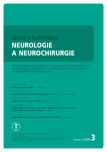Epidural application of steroids Part 2 – The quality of life of patiens before application
Authors:
J. Cabadaj; J. Hóborová; M. Prokopová
Authors‘ workplace:
Neurologická ambulance, Nemocnice, v Chebu, Karlovarská krajská nemocnice, a. s.
Published in:
Cesk Slov Neurol N 2020; 83/116(3): 323-329
Category:
Original Paper
doi:
https://doi.org/10.14735/amcsnn2020323
Overview
Aim: In the second part of the study concerning epidural corticosteroid applications, the authors collected data from 289 patients who were divided into three groups: “adults” (A; N = 103), “seniors” (S; N = 64) and “seniors with chronic pain” (SCP; N = 118). Data were evaluated using the World Health Organization Quality of Life Questionnaire (WHOQOL-BREF). The aim of the study is to evaluate the impact of the root lumbar spine syndrome, most commonly due to the prolapse of the intervertebral disc, on the overall quality of life, physical and mental health of patients coming in for the epidural corticosteroid application.
Patients and methods: The average age of the groups varies: 52.5 vs. 70.2 vs. 73 years. Otherwise, the groups are comparable to female representation and to pain rates of 4.7 on the Numeric Pain Rating Scale (NPRS). In addition, A and S groups are comparable in terms of the epidural corticosteroid application but they differ in Oswestry Disability Index (ODI) – A = 30.8% and S = 40.6%, which is approximately in the centre and at the upper limit of the medium disability zone.
Results: In all groups, the quality of life assessment and satisfaction with their health have a reduced value compared to the population norm, with the lowest rating found in the SCP group. In contrast to the population norm, the physical health domain rating is lower in all three groups, the A and S groups have the same rating of 21.39 and 21.41, resp., and the SCP group has a significantly lower rating for this domain of 10.66. The A group has values comparable to the population norm in domains of mental health, social relationships and environment. The S group has a score lower than the population norm in these domains, the SCP group has a lower score in the mental health and environment domains, and in the social-domain, the rating is higher than the population norm.
Conclusion: Most foreign studies with patients indicated for epidural corticosteroid application use the Short Form-36 questionnaire to assess the quality of life in patients with chronic low back pain.
Keywords:
Quality of life – epidural application of steroids – WHOQOL-BREF questionnaire
Sources
1. Dragomirecká E, Bartoňová J. Příručka pro uživatele České verze dotazníku kvality života. Praha: Psychiatrické centrum 2006.
2. Hnilicová H. Kvalita života a její význam pro zdravotnictví a medicínu. In: Payne J (ed). Kvalita života a zdraví. 1. vyd. Praha: Triton 2005.
3. Ware JE Jr, Sherbourne CD. The MOS 36-Item Short-Form health survey: I. Conceptual framework and item selection. Med Care 1999; 30 (6): 473–483.
4. McHorney CA, Ware JE Jr, Raczek AE. The MOS 36-Item Short-Form Health Survey (SF-36): II. Psychometric and clinical test of validity in measuring psychice and mental health constructs. Med Care 1993; 31 (3): 247–263. doi: 10.1097/00005650-199303000-00006.
5. Vaňásková E. Testování v rehabilitační praxi: cévní mozkové příhody. Brno: Národní centrum ošetřovatelství a nelékařských zdravotnických oborů 2004.
6. Dragomirecká E, Bartoňová J. Dotazník kvality života Světové zdravotnické organizace WHOQOL-BREF. Psychometrické vlastnosti a první zkušenosti s českou verzí. Psychiatrie 2006; 10 (3): 144–149.
7. Němec F, Chaloupka R, Krbec M et al. Hodnocení kvality života pacientů s degenerativním onemocněním bederní páteře. Act Chir Orthoped Traumat Cechoslov 2009; 76 : 20–24.
8. Siverová J, Bužgová R. Měření kvality života dotazníkem WHOQOL-BREF u pacientů s tuberkulózou. Ošetřovatelství a porodní asistence 2010; 1 (3): 66–73.
9. Cabadaj J, Hóborová J, Prokopová M. Epidurální aplikace kortikoidů. Část 1 – Profil pacient před aplikaci. Cesk Slov Neurol N 2019; 82/115 (6): 682–687. doi: 10.14735/amcsnn2019682.
10. Vítková J, Vaculín Š. Změny vnímání bolesti ve stáří. Bolest 2011; 14 (3): 129–132.
11. Kubešová H, Weber P, Meluzínová H. Specifické rysy diagnostiky a léčby bolesti v geriatrii. Bolest 2008; 11 (1): 16–22.
12. Danzigová Z. Bolest ve stáří. Bolest 2017; 20 (4): 173–179.
13. Kabarová I, Bužgová R. Hodnocení kvality života, adaptace a sociálního copingu seniorů s chronickou bolestí. Bolest 2014; 17 (1): 16-21.
14. Pokorná A, Eckelová I. Efektivita léčby bolesti z pohledu seniorů. Bolest 2013; 16 (2): 77–82.
15. Bohdalová H. Život pacientů s chronickou bolesti.České Budějovice: Jihočeská univerzita v Českých Budě-jovicích, Fakulta zdravotně-sociální 2009 : 58.
16. Uchmanowicz I, Kołtuniuk A, Stępień A et al. The influence of sleep disorders on the quality of life in patients with chronic low back pain. Scand J Caring Sci 2019; 33 (1): 119–127. doi: 10.1111/scs.12610.
17. Pieber K, Stein KV, Herceg M et al. Determinants of satisfaction with individual health in male and female patients with chronic low back pain. J Rehabil Med 2012; 44 (8): 658–663. doi: 10.2340/16501977-1010.
18. Casarett D, Karlawish J, Sankar P et al. Designing pain research from the patient’s perspective: what trial end points are important to patients with chronic pain? Pain Med 2001; 2 (4): 309–316. doi: 10.1046/j.1526-4637.2001.01041.x.
19. Brown CA. The beliefs of people with chronic pain in relation to ‘important’ treatment components. Eur J Pain 2004; 8 : 325–333.
Labels
Paediatric neurology Neurosurgery NeurologyArticle was published in
Czech and Slovak Neurology and Neurosurgery

2020 Issue 3
Most read in this issue
- Glioblastoma grade IV – long-term survival
- Primary progressive aphasia
- Headaches in pregnancy
- Cognitive disorders in children with epilepsy
